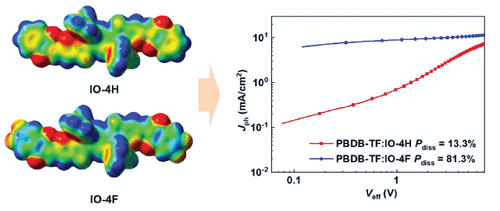当前位置:
X-MOL 学术
›
J. Phys. Chem. C
›
论文详情
Our official English website, www.x-mol.net, welcomes your feedback! (Note: you will need to create a separate account there.)
Efficient Exciton Dissociation Enabled by the End Group Modification in Non-Fullerene Acceptors
The Journal of Physical Chemistry C ( IF 3.7 ) Pub Date : 2020-03-26 , DOI: 10.1021/acs.jpcc.0c01003 Kaihu Xian 1, 2 , Yong Cui 1 , Ye Xu 1, 2 , Tao Zhang 1 , Ling Hong 1, 2 , Huifeng Yao 1 , Cunbin An 1 , Jianhui Hou 1, 2
The Journal of Physical Chemistry C ( IF 3.7 ) Pub Date : 2020-03-26 , DOI: 10.1021/acs.jpcc.0c01003 Kaihu Xian 1, 2 , Yong Cui 1 , Ye Xu 1, 2 , Tao Zhang 1 , Ling Hong 1, 2 , Huifeng Yao 1 , Cunbin An 1 , Jianhui Hou 1, 2
Affiliation

|
For organic photovoltaic (OPV) cells, in order to overcome the larger Coulombic binding energy between holes and electrons, an extra driving force is required for efficient exciton dissociation. Here, we report two nonfullerene acceptors named IO-4H and IO-4F for OPV cells. By employing the polymer PBDB-TF as a donor, the PBDB-TF:IO-4H-based device only shows a power conversion efficiency (PCE) of 0.30% with a charge dissociation probability (Pdiss) of 13.3%. On the contrary, the PBDB-TF:IO-4F-based device demonstrates a PCE of 7.85% with a Pdiss of 81.3%. The photoelectric processes demonstrate that both devices have similar charge transport and charge recombination properties. The limitation of photovoltaic performance is the low exciton dissociation efficiency in the PBDB-TF:IO-4H-based device. The theoretical studies show the electrostatic potential (ESP) of IO-4H is negative in the end groups and similar to the ESP of PBDB-TF, whereas ESP of IO-4F is positive. PBDB-TF and the IO-4F may form a strong intermolecular electric field to assist the exciton dissociation. Our results suggest that increasing the ESP difference between donor and acceptor may be beneficial to promote exciton dissociation, thus improving photovoltaic performance.
中文翻译:

非富勒烯受体端基修饰实现的有效激子离解。
对于有机光伏(OPV)电池,为了克服空穴与电子之间更大的库仑结合能,有效激子离解需要额外的驱动力。在这里,我们报告了两个用于OPV电池的非富勒烯受体IO-4H和IO-4F。通过使用聚合物PBDB-TF作为施主,基于PBDB-TF:IO-4H的器件仅显示出0.30%的功率转换效率(PCE),电荷离解几率(P diss)为13.3%。与此相反,在PBDB-TF:基于IO-4F-装置显示的7.85%的PCE与P DISS占81.3%。光电过程表明,两种器件都具有相似的电荷传输和电荷复合特性。光伏性能的局限性在于基于PBDB-TF:IO-4H的器件中激子解离效率低。理论研究表明,端基IO-4H的静电势(ESP)为负,类似于PBDB-TF的ESP,而IO-4F的静电势为正。PBDB-TF和IO-4F可能形成强大的分子间电场来辅助激子解离。我们的结果表明,增加供体和受体之间的ESP差异可能有利于促进激子离解,从而改善光伏性能。
更新日期:2020-03-27
中文翻译:

非富勒烯受体端基修饰实现的有效激子离解。
对于有机光伏(OPV)电池,为了克服空穴与电子之间更大的库仑结合能,有效激子离解需要额外的驱动力。在这里,我们报告了两个用于OPV电池的非富勒烯受体IO-4H和IO-4F。通过使用聚合物PBDB-TF作为施主,基于PBDB-TF:IO-4H的器件仅显示出0.30%的功率转换效率(PCE),电荷离解几率(P diss)为13.3%。与此相反,在PBDB-TF:基于IO-4F-装置显示的7.85%的PCE与P DISS占81.3%。光电过程表明,两种器件都具有相似的电荷传输和电荷复合特性。光伏性能的局限性在于基于PBDB-TF:IO-4H的器件中激子解离效率低。理论研究表明,端基IO-4H的静电势(ESP)为负,类似于PBDB-TF的ESP,而IO-4F的静电势为正。PBDB-TF和IO-4F可能形成强大的分子间电场来辅助激子解离。我们的结果表明,增加供体和受体之间的ESP差异可能有利于促进激子离解,从而改善光伏性能。



























 京公网安备 11010802027423号
京公网安备 11010802027423号